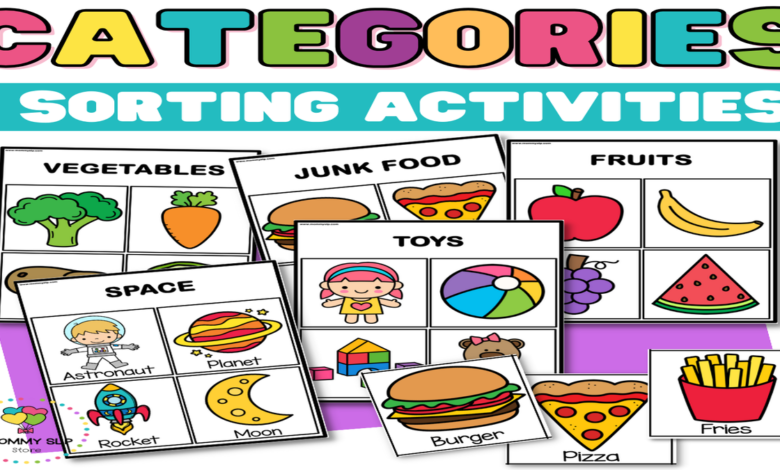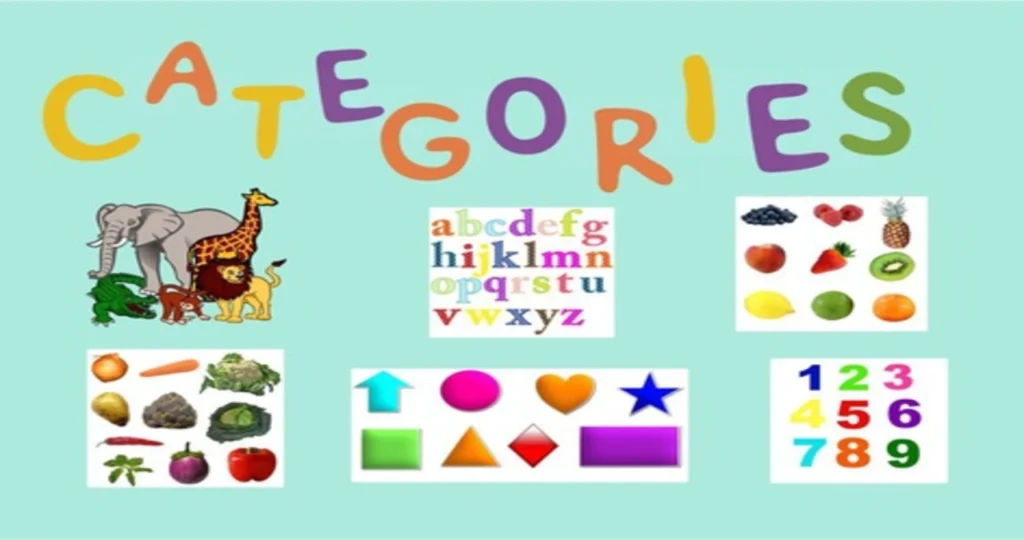Categories for Kids: 1Exploring Fun, Learning, and Growth

Categories for Kids When it comes to kids, there’s so much to consider in terms of their development, fun, and education. The world around them is filled with a vast array of activities, toys, and learning tools that help shape their growth. But how do we organize it all? How can parents, teachers, and caregivers efficiently sort and choose things for children? The answer lies in “categories for kids.” Categorizing toys, games, activities, and even education methods is crucial for helping kids thrive. This article will delve into various categories for kids, explore their importance, and offer suggestions on how they can benefit children.
Whether you’re a parent looking to enhance your child’s playtime, a teacher creating lesson plans, or simply someone who wants to understand more about how to organize children’s products and activities, this article will help guide you through it all.
Understanding the Importance of Categories for Kids
Kids are naturally curious, and as they grow, their interests and needs evolve. Categorizing things for them isn’t just about keeping everything neat and tidy—it’s also about offering structure and understanding. Categories for kids help to introduce order to the vast world of toys, learning, and entertainment. These categories provide focus, allowing children to navigate their world with ease, curiosity, and excitement.
How Categories Improve a Child’s Growth
Organizing activities and toys into categories helps children to easily identify what they are interested in and engage in them without feeling overwhelmed. Categories can range from simple things like sorting toys by type (e.g., action figures vs. building blocks) to more advanced systems that focus on skill development (e.g., cognitive skills, motor skills, and creativity).
When children are exposed to specific categories of toys or activities, they begin to associate different types of play with different kinds of learning. This enables them to not only have fun but also build critical skills, whether it’s social interaction, problem-solving, or imaginative thinking. This structure can also help parents or caregivers choose appropriate toys or activities based on the child’s age, interests, and developmental stage.

Categories for Kids: The Basics
Now that we understand the value of categorization, let’s dive into the categories themselves. Below, we will explore a variety of categories for kids, from playtime and learning to more specialized interests.
Toys and Play Categories
Play is a significant part of childhood development. There are many categories of toys designed to help kids learn and grow in different areas. Let’s break it down:
Educational Toys for Kids
Educational toys are designed to promote learning while still being fun. These toys help children acquire new skills and knowledge, often in a hands-on, interactive way. Think of toys that teach basic math, language, or problem-solving abilities. For example, building blocks help with spatial awareness and creativity, while puzzles improve cognitive abilities.
Kids’ educational toys can cover everything from basic literacy to complex STEM concepts. With the right educational toys, children can learn while playing, making the process enjoyable and effective.
Creative Play Toys
Creative play is essential for a child’s development, as it fosters imagination, emotional expression, and problem-solving. Creative toys encourage children to use their imagination and explore new ideas. Items like art supplies, building blocks, playdough, and even costumes fall into this category.
Creative play allows children to express themselves freely. Whether it’s through painting, pretending to be someone else, or constructing something from scratch, kids learn to think outside the box, hone fine motor skills, and improve social skills as they collaborate with others.
Physical Activity and Outdoor Toys
Physical activity is just as important as cognitive development. Active toys help children burn off energy, stay healthy, and develop motor skills. Examples include balls, scooters, jump ropes, and climbing structures. Outdoor toys, such as swings, trampolines, and bikes, also help children understand balance, coordination, and teamwork if used in group play.
Outdoor play is especially beneficial as it encourages exploration and helps build a child’s connection to the natural world, allowing them to engage in physical, social, and emotional development in a healthy and exciting environment.
Categories for Learning and Education
Beyond toys, several categories of learning tools and activities can help kids develop academic skills, emotional intelligence, and social behaviors.
Books and Reading Categories
Books are an essential part of any child’s growth and development. They introduce kids to the world, stimulate their imagination, and help with cognitive and language development. The categories of books can be divided into various themes and types, such as:
- Picture Books: Best for younger children, they help with visual literacy and introduce basic concepts like shapes, colors, and numbers.
- Storybooks: These are essential for fostering a child’s love of reading while enhancing vocabulary and comprehension.
- Non-fiction Books: These can teach kids about the world around them, from animals and nature to history and science.
- Interactive Books: These encourage participation from children with flaps to lift, textures to feel, or buttons to press.
Each category supports different aspects of a child’s development. Reading aloud to kids promotes bonding, language skills, and social-emotional growth, all while encouraging a lifelong love of books.
Educational Apps and Games
In the digital age, there are countless apps and online resources designed to enhance learning for kids. Educational games and apps can teach kids subjects ranging from math and science to art and geography. Categories for kids in this space include:
- Math and Science Games: These apps and games make complex subjects fun and easy to understand.
- Language and Literacy Apps: These can improve spelling, reading comprehension, and writing skills.
- Art and Creativity Apps: Tools for digital painting, animation, and music creation help kids express their creativity in a virtual world.
These educational apps provide kids with the opportunity to learn independently, while also being engaging and interactive, making learning fun and accessible.
Puzzles and Brain Games
Puzzles and brain games help kids enhance their problem-solving and critical-thinking skills. Categories of puzzles include:
- Jigsaw Puzzles: These improve spatial awareness, attention to detail, and patience.
- Logic Puzzles: These help enhance cognitive development and help kids think critically and logically.
- Memory Games: These games boost memory retention, recall skills, and concentration.
These games, which can be both physical or digital, play a significant role in helping kids develop their intellectual skills while having fun.
Categories for Social and Emotional Development
Children also need to learn how to navigate social situations, manage their emotions, and work in groups. There are toys, activities, and games designed specifically to promote social-emotional growth.
Role-Playing and Imaginative Play
Role-playing is a great way for kids to explore emotions, relationships, and social dynamics. Categories in this area include toys like dress-up costumes, dolls, and action figures. These toys encourage kids to think about how others feel and navigate social interactions in a safe, controlled environment. By pretending to be different characters, kids gain empathy and an understanding of the world from perspectives other than their own.
Role-playing games can also involve teamwork, teaching kids how to collaborate with others and work toward a common goal. Whether they’re building a pretend house, playing family roles, or acting out a scene, kids develop a greater sense of understanding and emotional intelligence.
Team-Based Games and Activities
Social interaction is an important part of childhood development. Games and activities that require teamwork help children develop social skills, such as communication, sharing, and problem-solving. Categories in this area include:
- Board Games: Games like “Monopoly,” “Scrabble,” or “Candyland” encourage turn-taking and friendly competition.
- Sports and Group Activities: Activities like soccer, basketball, or relay races teach kids how to cooperate with others to achieve a common goal.
- Cooperative Games: These games, where kids must work together to solve a problem or complete a task, can be both fun and educational.
Through these activities, children build social bonds and learn the importance of patience, teamwork, and positive communication.
Emotional Learning Tools
There are also toys and tools designed to help children understand and express their emotions. Categories in this area include:
- Emotion Cards: These cards depict different feelings and help kids identify and label their emotions.
- Therapeutic Dolls: Dolls can help children process and talk about their emotions in a safe, non-threatening way.
- Journals and Activity Books: These books can guide kids in reflecting on their feelings and experiences.
Such tools are critical for supporting children’s emotional growth, and helping them understand themselves and others better.
Categories for Kids’ Clothing and Accessories
While the focus is often on toys and educational tools, children’s clothing and accessories also come in categories that can play a role in their development and self-expression.
Themed Clothing
Themed clothing is a fun way for kids to express their personality and interests. From superhero shirts to princess dresses, themed clothing helps children connect with their favorite characters and stories, boosting their creativity and sense of identity.
Comfortable and Practical Clothing
Comfort is key when it comes to kids’ clothing. Categories for comfortable clothing include soft fabrics, adjustable sizes, and easy-to-wear designs. Ensuring that kids are comfortable in their clothes allows them to move freely, whether they’re at school, playing outside, or relaxing at home.
Conclusion: The Power of Categories for Kids
In conclusion, categories for kids are more than just labels for organizing toys and activities. They represent thoughtful choices that enhance a child’s play, learning, and development. Whether you’re selecting educational toys, planning a game to build social skills, or choosing books that nurture a love of reading, categories provide the structure needed for kids to explore, learn, and grow in meaningful ways.
As a parent, teacher, or caregiver, understanding these categories empowers you to make informed choices that align with your child’s needs and developmental stage. By offering kids a range of toys, activities, and learning tools categorized in ways that foster growth, you’re allowing them to become well-rounded, confident individuals who can thrive in both structured and creative environments
You may also read
1. Why is categorizing toys and activities important for kids?
2. How can categorization support a child’s development?
3. What are the key categories for kids’ toys?
Educational Toys (e.g., toys that teach math, language, or problem-solving).
Creative Play Toys (e.g., art supplies, building blocks, costumes for imaginative play).
Physical Activity and Outdoor Toys (e.g., balls, scooters, climbing structures).
4. How do books and reading fit into a child’s development?
Picture Books for visual literacy and early concepts.
Storybooks for fostering a love of reading and enhancing vocabulary.
Non-fiction Books for teaching about the world around them.
Interactive Books for hands-on learning and engagement.



